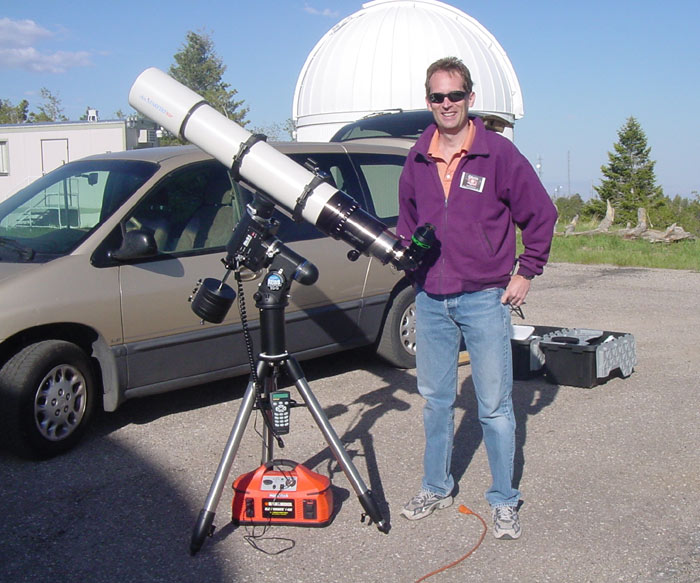|
Astronomy Camp May 2007 This was my 5th or 6th time helping out with the camp. It is always a privilege to be able to hob-knob with professional astronomers and use some remarkable equipment. Here is an aerial view of the
summit. Some of the highlights of this camp for me was to image a number of double stars with my webcam. Another highlight was to see Pluto with my own eyes through my Astro-Physics 160EDF. This is now the smallest scope I have ever seen Pluto in. I saw Pluto in a 10" scope about 10 years ago at the Texas star party and the 61" on Mt. Bigelow which was down right easy. With the help of "The Sky 5.0" I was able to orient myself to find the elusive 13.89 magnitude planet (yes I still think it is a planet!). This is right on the edge of the theoretical limit of what is possible with a 6 inch telescope. Three of the other campers were able to see it as well. It took some averted vision when the Pluto was low but became possible with direct vision by the time it was near the meridian. I used my 9mm eyepiece to get 133x as you can see in the image used from "The Sky" below.
Another highlight of the weekend was seeing the close conjunction (less than 2 degrees) of Venus with the moon on May 19th. The 2nd and the 3rd brightest natural objects in the sky so close together was a sight to be seen indeed!
Another highlight was the splitting of Antares in my AP160. This is a very challenging double to split, not due to the angular separation of 2.9 arc seconds, but due to the glare of 1st magnitude Antares A against it's 5.5th magnitude companion Antares B. Below is a webcam image taken on the night of May 19th clearly splitting this difficult pair.
Before we headed up the mountain we got to tour the Stewart Observatory Mirror Lab where they make the biggest single piece mirrors in the world. A whooping 8.4 meters (that's 330 inches to you an me)! They are spin cast with a honeycomb interior for lighter weight and more rapid cool-down. They can actually air condition the inside of the mirror This is a picture of the 8.4 meter mirror upside down with all the mirror supports attached.
Here is a picture of some of the campers next to the radar dome on the summit. "Who can see Venus first?" The guy in the shorts is Dr. Don McCarthy who runs the Astronomy Camp.
The first night on the mountain was spent at the 61" on Mt. Bigelow. Unfortunately the Declination encoder had a problem and so the scope would not move in Declination. Luckily it could be moved manually by spinning a flywheel and using the setting circles. It was like going back in time. I stayed until about 3 AM and then drove back up to the summit to sleep. I didn't sleep very soundly thanks in part to the 9100 foot elevation and visions of telescopes in my head. I was up and about by about 9 AM. They really feed you well at this camp. Breakfast was great and then we tried our hand at some solar observing but clouds kept forming right above us. We decided to take the scale model of the solar system hike with the sun the size of a plastic ball (about 9 inches in diameter). We made it to Neptune almost a mile away and then hiked back. I got a bit sunburned and while I'm in reasonably good shape I could definitely feel the altitude on my lungs. The second night was much more productive for me. I decided to setup and stay at the summit as the 20 minute drive to Mt. Bigelow didn't appeal to me since I had spent the previous 5 or 6 times helping with this camp on that scope exclusively. During this camp in fact I only looked through the big scopes a few dozen times, spending most of my time with my own equipment sharing the wider field spectacular views only a 6" APO can give. I really enjoyed talking with and sharing astronomy experiences with the other campers. It was a great group of people! One thing I did was to view Saturn through the 60" on Mt. Lemmon and then walk a few hundred feet to view it through my AP160. While the AP160 wasn't nearly as bright, I could see about as much detail. Very impressive for scope 10% the diameter! Astronomy camp is a wonderful emersion experience that should be experienced by anyone who has a passion for astronomy. For more information about the camp check out this link. |







